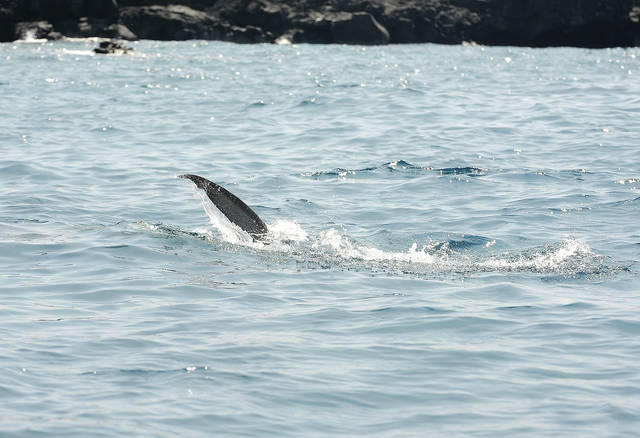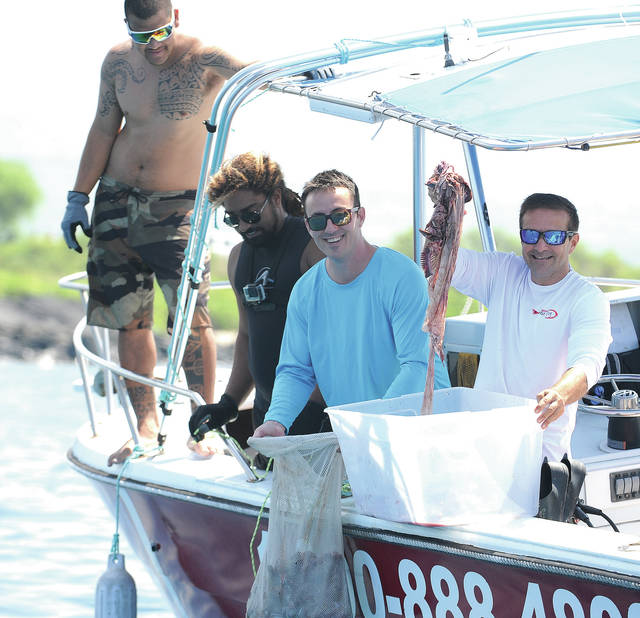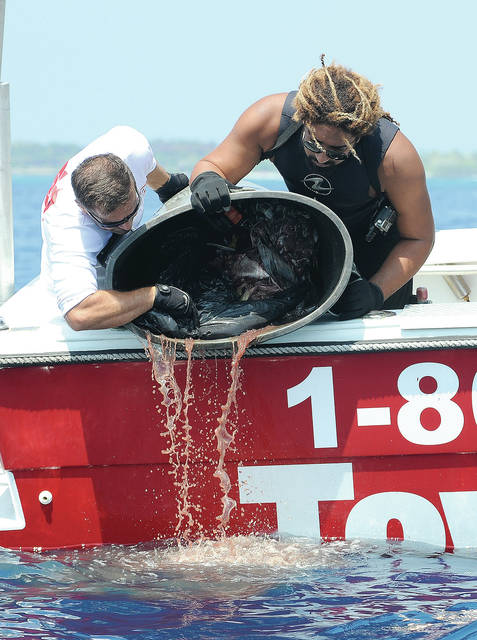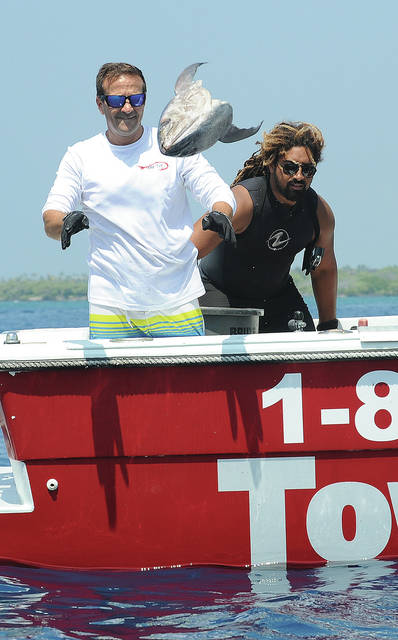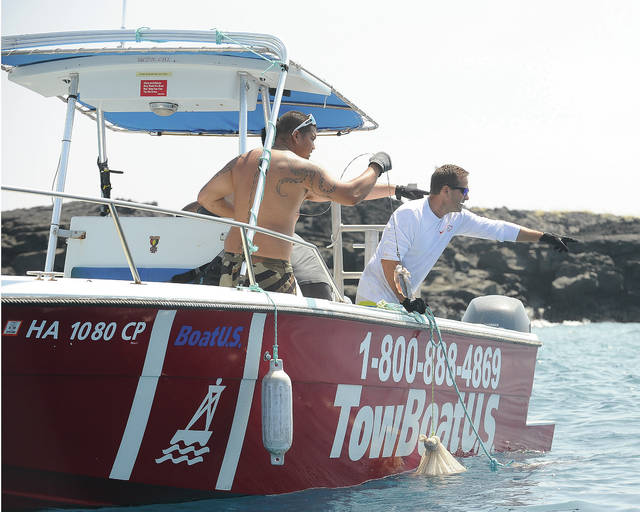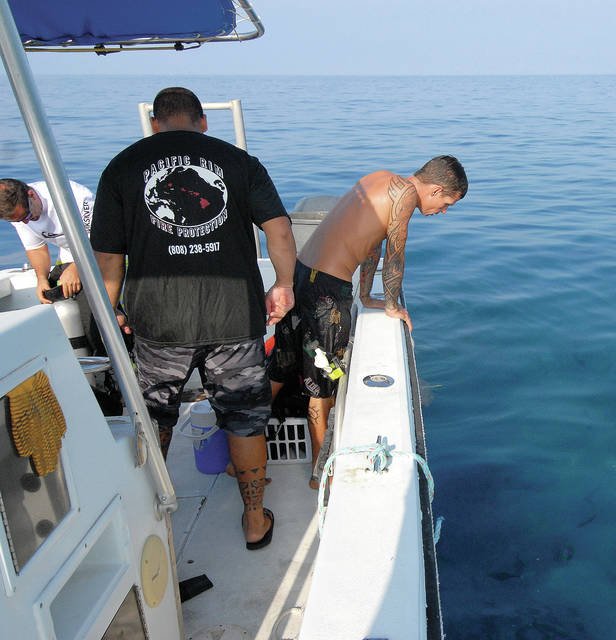Jaws of life
KAILUA-KONA — A couple weeks ago, a group of divers near Honokohau Harbor came across some tiger sharks.
That’s not exactly unusual; the area’s known for tiger shark sightings, said Ocean Eco Tours owner Rob Hemsher. The local shark population includes “resident mascot” Laverne, a 15-foot tiger shark who’s been around for several years.
One of the sharks — estimated at about 12 feet long and weighing about 1,000 pounds — had a rope taut around it, into a gill and the bottom of the animal’s fatty area.
“It looked like it was lassoed around the neck, almost like a dog collar,” Hemsher said. “And the rope’s old; it’s been on the animal for a while … I’m gonna estimate it’s been on the animal for four to six months.”
Kirk Campainha, who also saw the shark during that dive, said the debris posed a direct risk to the animal’s life.
“If it doesn’t get removed, it will eventually die,” he said.
It was enough for Campainha to spearhead a rescue effort and roundup a team of ocean lovers.
“It’s just a majestic species of fish,” he said. “Everybody’s just trying to do what they can; they don’t want to see it die an agonizing death.”
Kalei Villanueva; a diver, surfer and fisherman; said he found out about the shark from Campainha and said he thought it would be cool to help.
“I just like to help out, you know,” he said. “Always like to help out people or animals”
Also on the team was Joshua Lambus, founder and director of the Maka Project and who’s logged about 900 dives in the harbor over a span of 15 years.
“It’s a bummer,” he said of the situation. “It’s sad to see one of the big animals out here — the apex predators that are very important to the ecosystem and the reef — to be in trouble like that, especially by human means.”
But before the team could get underway with their mission, they first needed to make sure the whole process would be done above board.
The Division of Aquatic Resources, under the Department of Land and Natural Resources, prohibits the taking of any tiger shark, among other species, within the West Hawaii Regional Fishery Management Area.
As a result, the team undertook the effort to get a permit to undertake the mission.
Campainha credited DLNR staff from the Division of Aquatic Resources— specifically Cathy Gewecke, Megan R. Lamson and Lindsey Kramer — with quick action on getting the permit application approved, saying they all seemed to have the shark’s best interests in mind.
“All the people in the government really went above and beyond to make sure that permit got through fast; they usually don’t go through that fast,” Campainha said. “They were cognizant of the community trying to help.”
With the permit in hand, the team rolled out of Honokohau Harbor Saturday morning.
“The hardest part is finding a specific shark in a big ocean,” Hemsher said that morning as he patrolled the harbor looking for the shark.
Once sighted and identified, the plan from there was relatively straightforward, starting with hooking the shark.
After it’s hooked, the goal was to tire the shark out, bring it to the surface and flip it.
Sharks when flipped upside down go into a tonic state, rendering them immobile. At that point, they can cut the line and release the shark back into the water.
“And of course, you want to be careful because this could be potentially dangerous,” Hemsher added.
While the team did sight the shark that first day, they weren’t able to hook it and eventually had to return to the harbor to pick up their mission Monday morning.
But even though they weren’t able to complete what they set out to do, Hemsher said he already believed they were on track to success.
“First of all we were able to attract and identify the distressed shark; we were able to get close to it and we know that it’s still in the area, still alive,” he said.
He said a big hindrance was likely the result of an influx of people in the area.
At one point, there were a dozen divers in the water during the rescue effort and divers’ air bubbles could have scared off the sharks.
The effort continued Monday and again on Thursday, this time with coverage provided by state boats to keep away divers and other vessels.
And while their efforts got particularly close Thursday, the presence of other tiger sharks in the area — which presented the risk that the distressed shark might be attacked while hooked — ultimately sent the team back to the harbor, but not without the determination to keep trying to save her.
As the quest to de-tangle the shark from the line continues, those involved in the effort say they hope it’ll raise awareness about the danger marine debris poses to ocean life.
“Pretty much all of us, when we go out, we come back with handfuls of trash,” said Campainha. “But you know we can only go a little bit. You’d be surprised at what lays beyond where we can dive and you can see it all over the place. It’s actually terrible what’s out there.”
Lambus said he hopes the situation will wake people up to the issue of marine debris, saying that if there’s any positive thing that comes out of the shark getting tangled in the line, it’s that people recognize what a problem it is.
“The sharks here especially I think have sort of become kind of like a soft spot in people’s hearts for them,” he said. “People see ‘em; the divers see ‘em; fishermen going out on their boats see ‘em and we haven’t really had much in the way of any issues with them here. So I think it’s helped change people’s perceptions about sharks a bit, these specific sharks here at Honokohau. And so, also seeing one in trouble maybe helps further that eye-opening of the public.”


